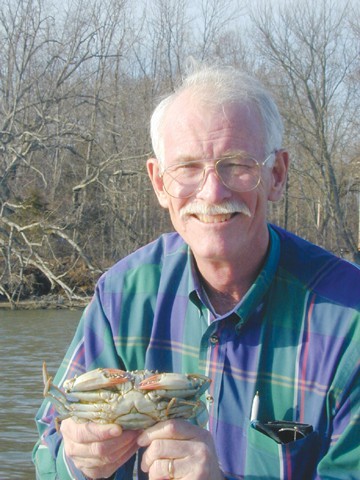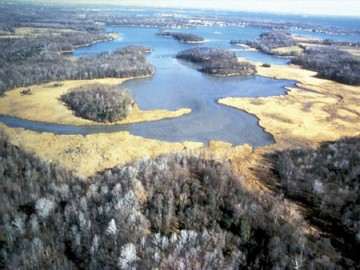A Bright — Green — New Future for the Smithsonian on the Chesapeake
There’s a new Smithsonian going up. Instead of the National Mall in Washington, D.C., this Smithsonian is rising out in the country southeast of Edgewater.
It’s so new that rising jumps the gun. The first spadeful of soil was turned only two weeks ago. But two years hence, the Mathias Lab will give the Smithsonian Environmental Research Center a place to work that’s as “high-tech sustainable” as the research scientists are doing there.
At the microscopic, hidden level where it counts, Smithsonian Environmental Research Center scientists are finding out what’s wrong with the Bay — putting the specifics of cause, and sometimes cure, into the generalizations of pollution, land-use and fisheries management.
“We all know it’s been a real struggle to sustain fisheries in the Bay and other coastal systems,” says director Anson ‘Tuck’ Hines. “Here we provide information on the basic ecology of species.”
What they’re doing will help other people in the line of Chesapeake defense make the right policy decisions.
Of course that’s only one of many kinds of research these Smithsonian scientists do. The Smithsonian Institution thrives on multiplicity. James Smithson’s 1829 bequest of $508,000 to the U.S. government “to create an establishment for the increase and diffusion of knowledge” was a fruitful investment.
The institution that bears the mineralologist’s name is the world’s largest museum and research complex, with 19 museums, nine research centers and a collection of countless objects.
As well as the Smithsonians we all know — Air and Space, Natural History, American History and the National Zoo — there are museums and research centers in New York, The Cooper-Hewitt National Design Museum; Fort Pierce, Florida, the Marine Station; and the base of Mt. Hopkins in the Santa Rita Mountains of Arizona, the Fred Lawrence Whipple Observatory — among others.
So why not a Smithsonian in Edgewater?
 |

That’s what dairy farmer Robert Forest said in the 1960s, when he willed his 365-acre Edgewater farm to the Smithsonian. The Institution kept it, increasing the holding to 2,650 acres with 15 miles of shoreline. The rolling, wooded tract looks much as it would have to Captain John Smith. Ninety-five percent remains open space and retains its biodiversity, which — along with what happens when land is developed — is one of the Center’s research themes.
In the 1970s, Maryland Sen. Charles ‘Mac’ Mathias secured Congressional funding for the laboratory that bears his name.
The Mathias Lab will grow, over the next two years, to 90,200 square feet, all of them as green as today’s technology can make them. The environmental standard is LEED Gold certification.
“It’s a challenge to design a lab and integrate it into this very sensitive setting,” says architect Howard Skoke of the firm Ewing Cole. “Doing no harm is as important as the architectural systems.”
Skoke says he has designed “a very well-detailed, low-key building in the architectural vernacular of the place: a long, low sloping, standing-seam, metal roof, horizontal lap siding brick, corrugated metal, lots of glass.”
Outside, inside and below, nearly every element has a job — or two — to do toward carbon neutrality, which Skoke says is the new environmental standard.
Roof-mounted solar panels will provide hot water, and almost 10 percent of the building’s electricity will come from some 650 solar panels.
The southern façade, where the labs are located, is highly transparent to maximize daylight and views. A large, north-facing, second-story clerestory brings daylight into the center of the building. Louvered sunshades and a deep roof overhang mitigate heat gain and glare.
A large geothermal field of 300- to 350-feet-deep wells helps heat and cool the lab.
Water — the subject of the Smithsonian Environmental Research Center — is sustainably managed.
Stormwater runs from the lab roof into cisterns or flows through runnels to a system of cascading pools lined with native plants. Stormwater from parking and roadways is also funneled to this system. The pools have a second job as experimental demonstration gardens.
The cisterns become industrial sculptural elements. Placed near the main entrance, they also, says the architect, “underscore ideas of conservation and stewardship.”
Wastewater will be reclaimed at a tertiary treatment plant for reuse in toilets, gardens and damping fires. A 60 percent reduction in potable water use is expected, on top of 100 percent potable water reduction for sewage.
With water, sun and geothermal energy — together with all the technologies of materials and planning —the Mathias Lab will stand as proof of what the Smithsonian Environmental Research Center is about: “Seeking real-world solutions for these challenging times,” as former governor Parris Glendening said at the May 6 groundbreaking.
“We want to be good stewards as well as solve problems,” Center director Hines told Bay Weekly. “We’re reducing energy and reusing water and materials to provide better quality space that makes for smarter and more ingenious scientists.”
